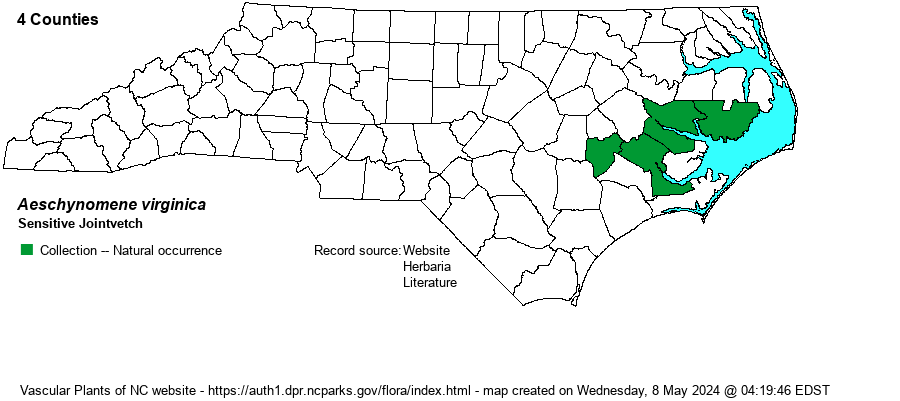| Author | (L.) Britton, Stearns, & Poggenburg | |
| Distribution | Historically only in the Tidewater zone, within a few miles of tidal water (but in fresh water conditions). Most records were from Hyde County, but the species has not been relocated in the past 5-10 years, despite intensive searches of former sites. There is a report of a specimen from Brunswick County (USDA website), but no specimen can be found at SERNEC as of 2022; thus, this county has been removed from the map below, as it is well south of the documented range along the mid-coastal area.
It has a very small range, only from southern NJ and coastally south to eastern NC.
| |
| Abundance | Formerly very rare, but now of "semi-historical" occurrence. In fact, in 2021, the NCNHP moved the State Rank from S1 to now SH, as it has not been re-found in recent years. It is a Federal and State Threatened species. | |
| Habitat | Its natural habitat is mainly tidal freshwater marshes, and into slightly brackish ones as well. Most NC records have actually been from ditches and wet fields, even in wet spots in croplands. These ditch and field habitats are/were close to tidal water, however. | |
| Phenology | Blooms from July to October, and fruits within a month after blooming. | |
| Identification | This is a rather robust and bushy-looking deciduous herb, growing to 2-3 feet tall, at times 5-6 feet tall. The leaves are even-pinnate, with about 30-50 very narrow leaflets, each 2/3-inch long but barely 1/8-inch wide. As with the very similar A. indica, this species has one to several pale to medium yellow flowers, mainly in leaf axils, with each flower averaging over 1 cm (2/5-inch) long, generally about 1/2-inch long; A. indica flowers are a bit smaller, under 2/5-inch long. Also, A. virginica flowers have the standard part greenish-yellow with distinct dark red veins, whereas A. indica has the standard pale orange or reddish-orange, with normally indistinct veins (Weakley 2018). It has a legume that is quite slender, about 1.5-2 inches long, but quite similar to that of A. indica. As a caution, this species has been easily confused with the much more numerous A. indica (and also with the newly-arrived exotic A. rudis), and as A. indica is probably 100 times or more numerous in NC than is A. virginica, you should assume you have found the "common" species unless or until proven otherwise. This species has been looked for in natural habitat in the extensive marshes around Currituck Sound, with no success. But, it still might turn up again in the many ditches or wet fields and croplands around or close to the margins of Lake Mattamuskeet. It is too early to give up hope of re-finding it again in the state. | |
| Taxonomic Comments | None
| |
| Other Common Name(s) | Northern Jointvetch, Virginia Jointvetch | |
| State Rank | SH | |
| Global Rank | G2 | |
| State Status | T | |
| US Status | LT | |
| USACE-agcp | FACW link |
| USACE-emp | OBL link |

